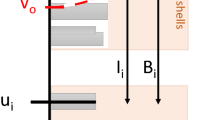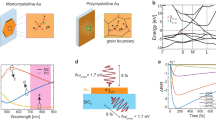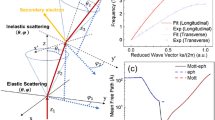Abstract
In a previous work, we extended and benchmarked the MDM Monte Carlo code with available data for gold metallic media irradiated by electron beams. In this paper, we worked with the aim of improving the cross sections on which our Monte Carlo simulation is based, and which are essential for an accurate description of the transport of electrons in gold. The mesoscopic potential of solid gold has been predicted, and its sensitivity toward electron emission has been evaluated. This potential was derived from the calculation of the electrostatic and atomistic potential by density functional theory and used to calculate inelastic inverse mean free path for electron transport. After integrating these results into our Monte Carlo code, we evaluated the impact of these new cross sections on yields of electron emission from solid gold irradiated by monoenergetic electron beams. We obtained a mesoscopic potential value of − 12.77 eV for our model of bulk metal gold, 27% lower than the one commonly estimated from the Fermi energy. This result impacted on the inverse mean free path for plasmon excitations with a 10% decrease for electrons in the range of 6–30 eV. Regarding electron emission yields, there was no impact of the new mesoscopic potential on the primary electron yields, but for secondary electrons, the emission yields were increased by a factor of up to two depending on the primary beam energy and thickness of the gold foil.







Similar content being viewed by others
References
J. Pierron et al., Electron emission yield for low energy electrons: Monte Carlo simulation and experimental comparison for Al, Ag, and Si. J. Appl. Phys. 121, 215107 (2017)
Y.T. Yue et al., Monte Carlo simulation of secondary electron and backscattered electron images for a nanoparticle-matrix system. J. Phys. D Appl. Phys. 38, 1966–1977 (2005)
C. Wälzlein et al., Simulations of dose enhancement for heavy atom nanoparticles irradiated by protons. Phys. Med. Biol. 59, 1441–1458 (2014)
F. Hespeels et al., Backscattered electron emission after proton impact on gold nanoparticles with and without polymer shell coating. Phys. Med. Biol. 64, 125007 (2019)
D. Pelowitz, MCNP6 User’s Manual, Version 1.0, LA-CP-13–00634, Rev. 0, Los Alamos National Laboratory, New Mexico, USA (2013)
S. Agostinelli et al., GEANT4: A simulation toolkit. Nucl. Instrum. Meth. A506, 250–303 (2003)
W.G. Shin et al., Development of a new Geant4-DNA electron elastic scattering model for liquid-phase water using ELSEPA code. J. Appl. Phys. 124, 224901 (2018)
D. Sakata et al., Electron track structure simulations in a gold nanoparticle using Geant4-DNA. Phys. Med. 63, 98–104 (2019)
D. Sakata et al., An implementation of discrete electron transport models for gold in the Geant4 simulation toolkit. J. App. Phys. 120, 244901 (2016)
D. Sakata et al., Geant4-DNA track-structure simulations for gold nanoparticles: the importance of electron discrete models in nanometer volumes. Med. Phys. 45(5), 2230–2242 (2018)
F. Poignant, et al., Theoretical derivation and benchmarking of cross sections for low-energy electron transport in gold. Eur. Phys. J. Plus 135, 358 (2020)
L. Reimer et al., Secondary electron emission of 10–100 keV electrons from transparent films of AL and Au. J. Phys. D Appl. Phys. 10, 805 (1977)
M. Beuve et al., Monte Carlo simulation of electron emission induced by Swift highly charged ions: beyond the linear response approximation. Eur. Phys. J. D 21, 125–135 (2002)
M. Beuve, thèse de l’université de CAEN (1999).
A. Jablonski et al., NIST Electron Elastic-Scattering Cross-Section Database Version 4.0, NIST Standard Reference Database Number 64, National Institute of Standards and Technology, Gaithersburg MD, 20899, (2016).
R. G. Newton, Scattering Theory of Waves and Particles (McGraw Hill, 1966).
G. Kresse et al., Ab-initio Molecular dynamics for liquid metals. Phys. Rev. B 47, 558 (1993)
G. Kresse et al., Efficiency of ab-initio total energy calculations for metals and semiconductors using a plane-wave basis set. Comput. Mat. Sci. 6, 15–50 (1996)
G. Kresse et al., Efficient iterative schemes for ab-initio total-energy calculations using a plane-wave basis set. Phys. Rev. B 54, 11169 (1996)
J.P. Perdew et al., Generalized gradient approximation made simple. Phys. Rev. Lett. 77, 3865 (1996)
S. Grimme et al., A consistent and accurate ab initio parametrization of density functional dispersion correction (DFT-D) for the 94 elements H-Pu. J. Chem. Phys. 132, 154104 (2010)
G. Kresse et al., Fromultrasoftpseudopotentials to the projector augmented-wave method. Phys. Rev. B 59, 1758 (1999)
F. Salvat et al., ELSEPA-Dirac partial-wave calculation of elastic scattering of electrons and positrons by atoms, positive ions and molecules. Comput. Phys. Commun. 165, 157–190 (2005)
Y.-K. Kim et al., Binary-encounter-dipole model for electron transport ionization. Phys. Rev. A 50, 3954–3967 (1994)
W. Hwang et al., New model for electron-impact ionization cross sections of molecules. J. Chem. Phys. 104, 2965 (1996)
B. Gervais et al., Numerical simulation of multiple ionization and high LET effects in liquid water radiolysis. Radiat. Phys. Chem. 75, 495–513 (2006)
R. Ritchie, Interaction of charged particles with a degenerate Fermi-Dirac electron gas. Phys. Rev. 114, 644–654 (1959)
Acknowledgements
This work was supported by the LABEX PRIMES (ANR-11-LABX-0063) of Université de Lyon, within the program “Investissements d’Avenir” (ANR-11-IDEX-0007) operated by the French National Research Agency (ANR). The authors thank GENCI in Paris (project 609) and PSMN in Lyon for CPU time and assistance. The authors thank the CPER/SYSPROD 2015-2022 project (N°2019-AURA-P5B) and AXELERA Pôle de Compétitivité for financial support (PSMN Data Center).
Author information
Authors and Affiliations
Corresponding author
Rights and permissions
About this article
Cite this article
Ramos, R., Poignant, F., Chan, CH. et al. Low-energy electron transport in gold: mesoscopic potential calculation and its impact on electron emission yields. Eur. Phys. J. Plus 136, 345 (2021). https://doi.org/10.1140/epjp/s13360-021-01318-x
Received:
Accepted:
Published:
DOI: https://doi.org/10.1140/epjp/s13360-021-01318-x




